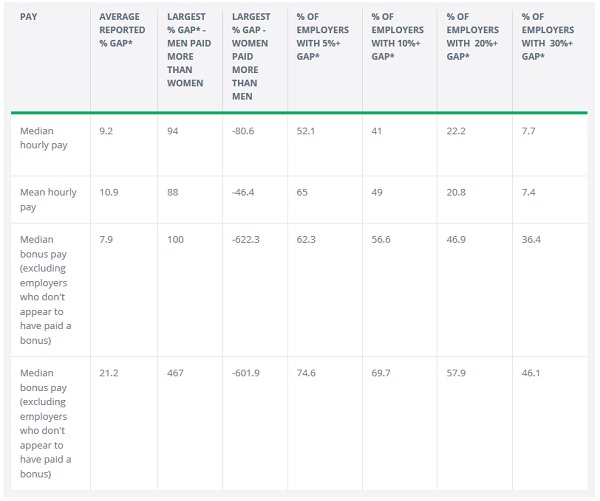On 6 April 2017, new laws came into force requiring employers with at least 250 employees to report their gender pay gap. At the time of writing, eight months on and with just under four months until the deadline for reporting, 351 employers have reported their gender pay figures on the government sponsored website set up for this purpose.
We have analysed the information published so far and explain here what the data shows, the reasons given by employers for pay gaps, and what they say they are doing to close them.
What are employers are required to do?
Employers who are subject to gender pay reporting requirements have until 4 April 2018 to publish their gender pay figures, based on a 'snapshot' of the picture as it was on 5 April 2017 - and must publish further figures annually thereafter. The figures must include the following:
- median gender pay gap figures for hourly pay and bonus pay – by identifying the pay of the middle earner, the median is said to be the best representation of the typical difference in pay between men and women
- mean gender pay gap figures for hourly pay and bonus pay – by identifying the pay of the average earner, the mean takes into account the low and high earners in an organisation – this is useful because women are often over-represented at low-earning levels and men are over-represented at the higher-earning levels
- the proportion of men and women who received a bonus – there is said to be a significant issue around bonus payments in some sectors and as a result employers must also publish the proportion of men and women who received a bonus during the year
- the proportion of men and women in each quartile of the pay structure – this data shows the spread of male and female earners across the organisation and enables employers to see where the progress of women may be stalling
Employers must publish these figures in a gender pay report on their searchable UK website (in a manner that is accessible to all employees and the public) and on a dedicated government website.
Our previous update explains what employers are required to do in more detail.
Analysis of the gender pay gap data published so far
Who has reported?
The figures published so far can be viewed on the government website here. At the time of writing, 351 employers have published their gender pay gap figures on this website, and this includes a number of separate entries for companies in the same group of companies. The government estimates that 9,000 employers, covering 15 million employees (almost half the UK's workforce), will have to report their gender pay gap figures by April 2018, so the vast majority of employers have yet to publish their figures.
The sectors that have been first 'off the mark' in relation to gender pay reporting (adopting the sector breakdowns used by the government in relation to gender pay reporting) are: the Public Sector (50 employers), Human Health and Social Work Activities (46 employers), Manufacturing (44 employers), Wholesale and Retail Trade (36 employers), Administrative and Support Service Activities (34 employers), Education (30 employers) and Professional Scientific and Technical Activities (30 employers)).
What does the data show?
The UK pay gap is at a record low of 18.1% for all employees and 9.4% for full-time employees (based on statistics published by the Office for National Statistics in 2016). In line with this, perhaps unsurprisingly, most of the published gender pay gap figures show that women are paid less than men.
This table sets out our analysis of the gender pay gap figures reported, showing the percentage pay gaps (as at 12 December 2017) of those who have published their reports - 228 of which made bonus payments in the relevant period. All columns marked * indicate the percentage gap where men are paid more than women.

As this table shows, the overall average gender pay gaps reported by employers so far are lower than the overall UK gender pay gap announced by the Office for National Statistics. This is likely to be due to the structural make-up of the employers that have published their reports so far, and the fact that the figures reported include both full and part-time employees. It is likely that the figures will fluctuate as more employers publish their reports. However, of those employers who have reported their pay gaps so far, over 40% have a gap of 10% or more and over 20% have a gap of 20% or more in median hourly pay where men are paid more than women.
In the reports that have been published so far, while there are a number of employers with pay gaps that are higher than the overall UK pay gap, there are also employers that have pay gaps where women are paid more than men. A negative figure in the data indicates that the average pay of men is lower than the average pay of women.
The disparities in relation to bonus pay appear to be largely explained by the structural make-up of the organisations that have reported, with higher bonuses being paid to employees in more senior roles which are held disproportionately by men and the fact that more women than men work part-time and receive pro-rata bonuses. As can be seen from the table above, there are some particularly large gaps in bonus pay (e.g. a median bonus pay gap of -622.3) which in some cases are explained by the gender makeup of a particular employer's workforce, such as where all employees are of a particular sex.
The overall percentages of men and women across all of the organisations who have reported so far who received a bonus are similar - this appears to be due to the fact that in some organisations more women received a bonus than men, whilst in others more men than women received a bonus. The findings in relation to this point may be influenced by the structural make-up of the employers that have reported so far.
The quartile figures reported so far show that, as expected, women are more highly represented in the lowest earning quartile (with 46% men and 54% women), although perhaps by not as much as we would have expected to see, and men are disproportionately more highly represented in the highest earning quartiles (with 59% men and 41% women in the top earning quartile and 53% men and 47% women in the upper middle quartile). Men and women are equally represented in the lower middle quartile of earners.
What are employers saying about their gender pay gaps?
Although there is no requirement to include a narrative alongside the gender pay figures, a number of employers have chosen to do so. Providing a narrative enables employers to put the figures into context, explain any pay gaps and set out any steps they are taking to narrow the pay gaps. A number of key themes and different approaches emerge from the narratives published by employers to date, including the following:
- Structural issues - a number of employers explain that their gender pay gaps are largely driven by the fact that there are more men than women in senior higher-paid roles within their businesses. Some employers have provided additional data showing a narrower gender pay gap once an adjustment is made to reflect the greater number of men in senior higher-paid roles
- Male-dominated industries - a number of employers in male-dominated industries, such as manufacturing and engineering, highlight the gender imbalance in their industries as a major cause of their gender pay gaps. The fact that fewer girls take STEM subjects (Science, Technology, Engineering, and Mathematics) at school, and therefore enter related careers in fewer numbers, is referred to as a key issue faced. The STEM workforce is made up of just 21% women, according to WISE UK Statistics in 2016. The government is currently taking steps to encourage more girls to take STEM subjects in an effort to address this imbalance
- Putting figures into sector context – employers may explain that whilst their pay gap is higher than the overall UK pay gap, it is lower than the average pay gap for their sector
- Bonus pay gap - two key themes emerge from the narratives in relation to the bonus pay gap. Firstly, a number of employers highlight the fact that more women than men work part-time and therefore only receive a pro-rated bonus. Secondly, a number of employers note that higher bonuses tend to be paid to more senior employees, and that fewer women are in those positions. These factors lead to a wider bonus pay gap between the sexes
- Highlighting achievements in equality made to date - some employers refer to achievements already made in addressing gender imbalances (e.g. meeting the government's targets in relation to women on Boards or attracting more female graduates). Some have set future targets for reducing their gender pay gaps and addressing gender inequality
- Showing progress over time - some employers who voluntarily published gender pay gap figures in previous years have been able to explain how those gaps have changed over time, including highlighting where they have narrowed
- Amalgamating group figures - some large organisations that are required to provide separate gender pay figures for different companies within their group structures, have provided overall figures in the gender pay reports published on their own websites or explained the reasons for differences across different companies within their groups
What are employers doing to try to narrow gender pay gaps?
Many employers have provided information about the steps they are taking in an effort to narrow the gender pay gap, including:
- reviewing recruitment processes and taking steps to ensure they are free of bias (e.g. ensuring all hiring managers receive training on inclusivity in recruitment and having a female panel member on all selection panels)
- reviewing decisions in relation to pay, bonuses and performance
- offering flexible working opportunities (including in relation to senior roles)
- reviewing retention strategies
- implementing return-to-work programmes to support employees who have been on extended periods of absence (e.g. maternity leave or a career break)
- supporting the career development of employees as part of mentoring and career development programmes
- implementing working parents programmes and providing benefits to help support working parents
- setting up networking programmes to help employees broaden their networks and progress their careers
- supporting wider initiatives to encourage school-age girls to study STEM subjects and pursue related careers (e.g. hosting open days and workshops targeted at girls at secondary school) and attempting to break down gender stereotypes in relation to traditionally male-dominated careers (such as including female employees in adverts, brochures and at careers events)
- management and leadership programmes to help employees develop the skills necessary to progress in seniority
- linking senior executive team pay to delivery of internal targets on gender diversity
- encouraging employees to raise issues that they believe contribute to gender inequality in the workplace
- training all managers/employees in relation to diversity and inclusion
- using what are referred to as 'gender balanced' or 'diversified' shortlists for particular roles and setting targets for numbers of women at particular levels
Clyde & Co have been advising clients on many gender pay issues, ranging from calculating the pay gap and drafting gender pay reports (including steps to reduce the gap) to assisting with diversity initiatives and programmes.
The content of this article is intended to provide a general guide to the subject matter. Specialist advice should be sought about your specific circumstances.

